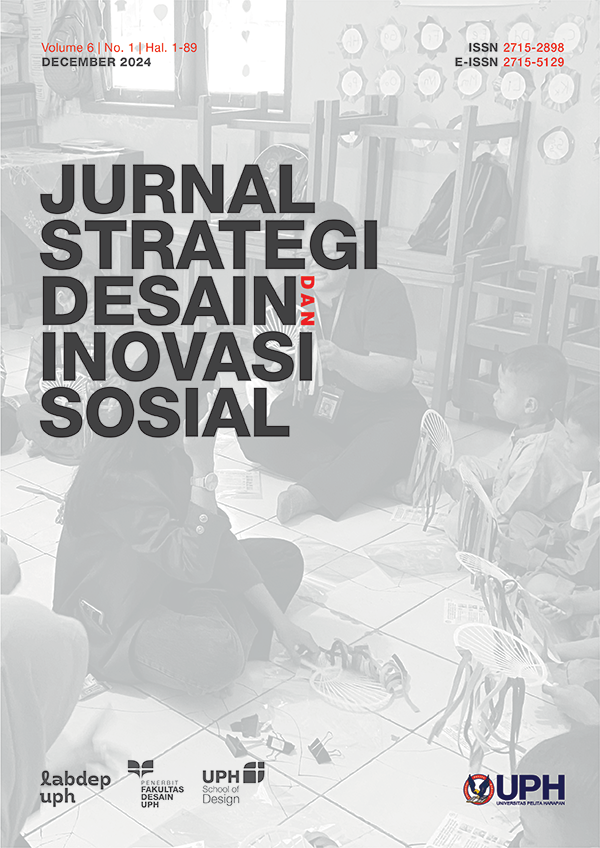Artificial Intelligence-based Outpainting Technology: TikTok Effect Features in the Perspective of Elegant Design Composition
Περίληψη
Outpainting is one of art technologies based on artificial intelligence. Feature contained in TikTok application is able to expand uploaded the image. The image expansion system is supported by application of AI technology that is able to fill in empty parts of original image. this benefit can be achieved by identifying work patterns and understanding results of feature. It is necessary to understand concept of applying AI technology to produce images that are wider than the original photo. Therefore, an attempt was made to examine content results of Outpainting from perspective of elegant composition design. The experiment was conducted by uploading two photos that have different compositions, objects, complexity, and details of each image. In addition, the discussion of output results of technology is to find advantages and disadvantages of Outpainting feature found in TikTok application. Research strategies uses a descriptive process with trials and literature sources so as to explore good quality and in-depth data.
Αναφορές
Adams, N. (2019). How Artificial Intelligence Works How Artificial Intelligence < Currently > Works [ Working Paper ] For this paper , a basic introduction to how AI works is most apt . The writer follows tradition by introducing AI by comparing it to a human . In particul. November.
Al Asy ari, M. K. H., & Rahman, M. (2020). Technology: Technological Advances and Changes in Human Lifestyles in a Socio-Cultural Perspective. Proceeding International Conference on Science and Engineering, 3(April), 721–730. https://doi.org/10.14421/icse.v3.592
Alamri, W. A. (2019). Effectiveness of Qualitative Research Methods: Interviews and Diaries. International Journal of English and Cultural Studies, 2(1), 65. https://doi.org/10.11114/ijecs.v2i1.4302
B, X. F., Luo, J., & Wang, X. (2023). Proceedings of the 2022 4th International Conference on Literature, Art and Human Development (ICLAHD 2022). In Proceedings of the 2022 4th International Conference on Literature, Art and Human Development (ICLAHD 2022) (Vol. 1). Atlantis Press SARL. https://doi.org/10.2991/978-2-494069-97-8
Babić, S. (2023). Archaeological programmes. Notes on epistemic diversity. ARS AND HUMANITAS, XVII(2).
Bani, R. (2023). Impact of Artificial Intelligence Technology in Fine Art: in Reference of Printmaking. ShodhKosh: Journal of Visual and Performing Arts, 4(2), 142–148. https://doi.org/10.29121/shodhkosh.v4.i2.2023.553
Božić, V. (2023). Artificial Intelligence as the Reason and the Solution of Digital Divide. Language Education & Technology (LET Journal), 3(2), 96–109. https://doi.org/10.13140/RG.2.2.10494.66880
chanda, armstrong. (2022). Key Methods Used in Qualitative Document Analysis. SSRN Electronic Journal, 1990, 1–9. https://doi.org/10.2139/ssrn.3996213
Chong, L., & Yang, M. (2023). Ai Vs. Human: the Public’S Perceptions of the Design Abilities of Artificial Intelligence. Proceedings of the Design Society, 3(July), 495–504. https://doi.org/10.1017/pds.2023.50
Cresswell, J. W. and J. D. C. (2018). Fifth Edition Research Design: Qualiative, Quantitative, and Mixed Methods Approaches. Sage Publications, Inc.
Crossley, S. A., & McNamara, D. S. (2016). Adaptive educational technologies for literacy instruction. Adaptive Educational Technologies for Literacy Instruction, 1–310. https://doi.org/10.4324/9781315647500
Dahal, J., Tiwari, S., Shrestha, S. P., & Bhandari, U. (2021). Evaluation of marigold (Tagetes erecta) varieties for growth, flowering, and floral attributes at three localities of Nepal. Jornamental.Rasht.Iau.Ir, 11(September), 209–219. https://jornamental.rasht.iau.ir/article_685575.html
Fan, X., & Liang, Y. (2023). The Research on the Characteristics of AI Application in Art Field and Its Value (Vol. 1). Atlantis Press SARL. https://doi.org/10.2991/978-2-38476-094-7_18
Indrawati, Putri Yones, P. C., & Muthaiyah, S. (2023). eWOM via the TikTok application and its influence on the purchase intention of somethinc products. Asia Pacific Management Review, 28(2), 174–184. https://doi.org/10.1016/j.apmrv.2022.07.007
Jeffry, E., Achmad, S., Danial, M. F., & Sutoyo, R. (2015). The Impact Of Artificial Intelligence on Art - A Systematic of Literature Review. 2(JANUARY), 1–9. https://doi.org/10.1109/ITIS59651.2023.10420208
Khan, S. A., Chowdhury, M. M. H., & Nandy, U. (2023). AI Robotics Technology: A Review. Journal of Engineering Research and Reports, 25(10), 187–194. https://doi.org/10.9734/jerr/2023/v25i101011
Liao, S., & Ji, X. (2024). A Study on the Application of Generative Artificial Intelligence Technology in Image Design (Issue Icidit 2023). Atlantis Press International BV. https://doi.org/10.2991/978-94-6463-266-8_36
Liu, B. (2023). Arguments for the Rise of Artificial Intelligence Art: Does AI Art Have Creativity, Motivation, Self-awareness and Emotion? Arte, Individuo y Sociedad, Avance en(October), 1–11. https://doi.org/10.5209/aris.83808
Luca Iandoli, G. Z. (2022). Elegant Design - A Designer’s Guide to Harnessing Aesthetics. Bloomsbury Publishing Plc.
Meliawati, T., Gerald, S. C., & Akhmad Edhy Aruman. (2023). The Effect of Social Media Marketing TikTok and Product Quality Towards Purchase Intention. Journal of Consumer Sciences, 8(1), 77–92. https://doi.org/10.29244/jcs.8.1.77-92
Mennborg, A. (2021). AI-Driven Image Manipulation Image Outpainting Applied on Fashion Images.
Miltsov, A. (2022). Researching TikTok: Themes, Methods, and Future Directions. The SAGE Handbook of Social Media Research Methods, October, 664–676. https://doi.org/10.4135/9781529782943.n46
Nurcahyo, A., Suroso, J., & Wang, G. (2022). The Artificial Intelligence (AI) Model Canvas Framework and Use Cases. Jurnal Ilmiah Teknik Elektro Komputer Dan Informatika, 8(1), 1. https://doi.org/10.26555/jiteki.v8i1.22206
Okagbue, E. F., Ezeachikulo, U. P., Nwigwe, E. O., & Juma, A. A. (2022). Machine Learning and Artificial Intelligence in Education Research: A Comprehensive Overview of 22 Years of Research indexed in the Scopus Database. ResearchSquare, 1–27. https://doi.org/10.21203/rs.3.rs-1845778
Oksanen, A., Cvetkovic, A., Akin, N., Latikka, R., Bergdahl, J., Chen, Y., & Savela, N. (2023). Artificial intelligence in fine arts: A systematic review of empirical research. Computers in Human Behavior: Artificial Humans, 1(2), 100004. https://doi.org/10.1016/j.chbah.2023.100004
Petropoulos, F., Apiletti, D., Assimakopoulos, V., Babai, M. Z., Barrow, D. K., Ben Taieb, S., Bergmeir, C., Bessa, R. J., Bijak, J., Boylan, J. E., Browell, J., Carnevale, C., Castle, J. L., Cirillo, P., Clements, M. P., Cordeiro, C., Cyrino Oliveira, F. L., De Baets, S., Dokumentov, A., … Ziel, F. (2022). Forecasting: theory and practice. International Journal of Forecasting, 38(3), 705–871. https://doi.org/10.1016/j.ijforecast.2021.11.001
Singh, S., Aggarwal, N., Jain, U., & Jaiswal, H. (2020). Outpainting Images and Videos using GANs. International Journal of Computer Trends and Technology, 68(5), 24–29. https://doi.org/10.14445/22312803/ijctt-v68i5p107
Tai, M. C. T. (2020). The impact of artificial intelligence on human society and bioethics. Tzu Chi Medical Journal, 32(4), 339–343. https://doi.org/10.4103/tcmj.tcmj_71_20
Wang, X., Cheng, W., & Jia, W. (2022). Structure-guided Image Outpainting. http://arxiv.org/abs/2212.12326
Yao, K., Gao, P., Yang, X., Sun, J., Zhang, R., & Huang, K. (2022). Outpainting by Queries. Lecture Notes in Computer Science (Including Subseries Lecture Notes in Artificial Intelligence and Lecture Notes in Bioinformatics), 13683 LNCS, 153–169. https://doi.org/10.1007/978-3-031-20050-2_10
Yu, J. X. (2019). Research on TikTok APP Based on User-Centric Theory. Applied Science and Innovative Research, 3(1), 28. https://doi.org/10.22158/asir.v3n1p28
Yusriadi, Y., Rusnaedi, Siregar, N. A., Megawati, S., & Sakkir, G. (2023). Implementation of artificial intelligence in Indonesia. International Journal of Data and Network Science, 7(1), 283–294. https://doi.org/10.5267/j.ijdns.2022.10.005
Zeng, J., Abidin, C., & Schäfer, M. S. (2021). Research Perspectives on TikTok & Its Legacy Apps. International Journal of Communication, 15(September), 3161–3172.
Zevalkink, J. (2021). Observation method. Mentalizing in Child Therapy, May, 100–113. https://doi.org/10.4324/9781003167242-6
Λήψεις
Δημοσιευμένα
Τεύχος
Ενότητα
Άδεια
Πνευματική ιδιοκτησία (c) 2025 Achmad Nur Kholis, Setyo Budi, Desy Nurcahyanti

Αυτή η εργασία είναι αδειοδοτημένη υπό το CC Αναφορά Δημιουργού – Μη Εμπορική Χρήση – Παρόμοια Διανομή 4.0.
Dengan mempublikasikan artikel pada Jurnal Strategi Desain dan Inovasi Sosial (JSDIS), penulis setuju bahwa:
- Penulis memegang penuh hak cipta atas artikel yang dipublikasikan.
- Penulis tidak pernah mempublikaskan artikel penulis dalam publikasi lainnya.
- Penulis dilarang mempublikasikan artikel yang sudah diterbitkan JSDIS tanpa mencantumkan bahwa artikel tersebut sebelumnya sudah pernah diterbitkan di JSDIS.
- Redaksi JSDIS memiliki hak untuk mempublikasikan, mendistribusikan, dan menggunakan artikel penulis untuk keperluan publikasi jurnal dengan tetap mencantumkan penulis sebagai pemegang hak cipta.



.jpg)
